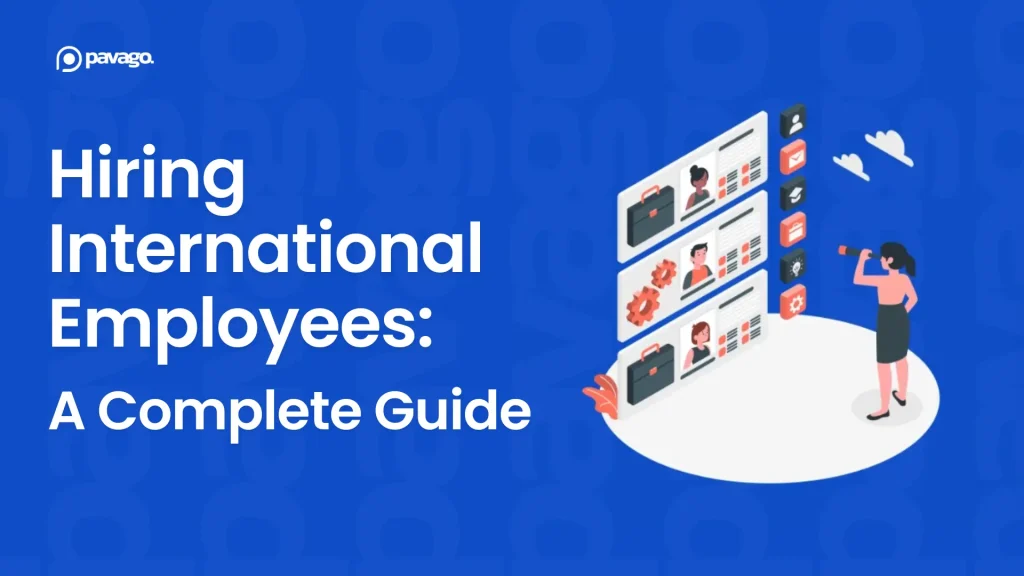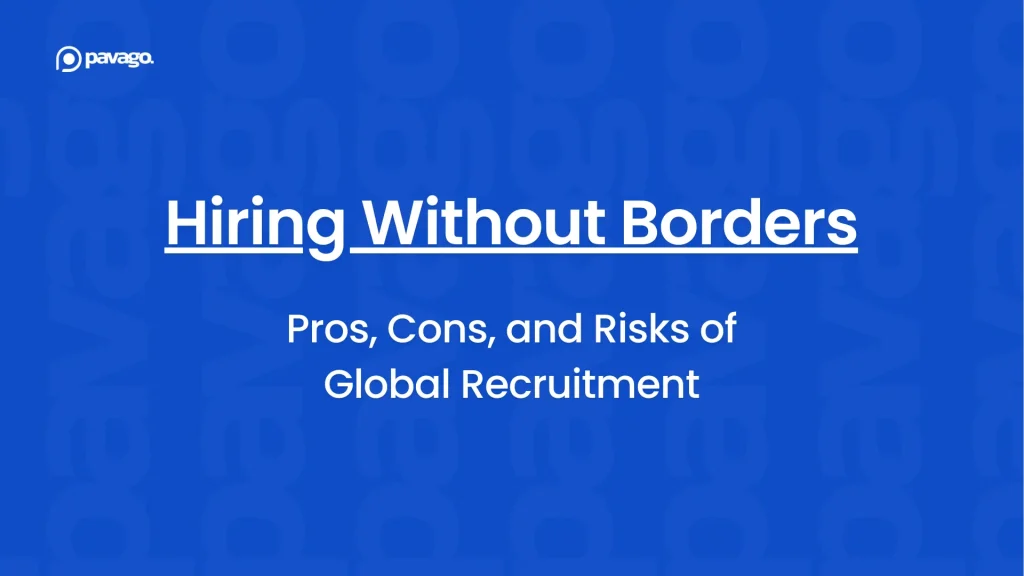Let’s be honest – finding good talent in the U.S. is getting harder and more expensive every year. That’s why 73% of companies are now looking globally to build their teams.
And with remote work being totally normal now, hiring someone in Mexico or Pakistan is just as easy as hiring someone in the next state over.
Here’s the thing: you can tap into a global talent pool of 3.5 billion skilled workers and often save 40-60% on costs compared to domestic hiring. But (and it’s a big but) you need to do it right.
Mess up the legal stuff, and you could face hefty fines, tax problems, or worse.
Don’t worry, though – this guide will walk you through exactly how to hire international employees without the headaches.
We’ll cover the legal ways to do it, which countries work best, and how to avoid the common mistakes that trip up most companies.

Best Countries for Hiring International Talent
1. The Philippines
Why companies love it: Excellent English, work during U.S. hours, and they’ve been doing remote work longer than anyone.
Popular roles: Customer service, virtual assistants, accounting, and content creation.
Heads up: Labor laws heavily favor employees, and you’ll probably have to pay a 13th-month bonus.
2. Pakistan
The appeal: A growing talent pool with competitive rates, especially in tech and customer support.
What they’re good at: Software development, customer service, digital marketing, and finance.
The catch: Limited infrastructure in some areas, but rapidly improving.
Related: How to Hire & Pay Remote Employees in Pakistan
3. Mexico
Why it works: Same time zones, USMCA trade benefits, growing tech scene.
Popular roles: Software development, customer service, and manufacturing support.
Watch out for: Strong labor unions and mandatory profit sharing.
4. South Africa
Why it’s working: Skilled, English-speaking workforce, close time zone to Europe, competitive pricing.
What they excel at: Customer service, IT support, digital marketing, sales.
Watch out for: Higher turnover in certain industries and fluctuating exchange rates.
5. Colombia
Getting popular because: Great English skills, favorable time zones, competitive costs.
They excel at: Customer service, digital marketing, creative work.
Just know: Employment contracts are pretty rigid once signed.

Legal Ways to Hire International Employees
You’ve got four main options for hiring employees in foreign countries, each with its own pros and cons.
1. Employer of Record (EOR) Services
This is probably your best bet if you’re just starting out. An EOR company becomes the legal employer on paper while you manage the day-to-day work. They handle all the messy legal stuff:
- Employment contracts that actually comply with local laws
- Payroll, taxes, and all those government payments
- Health insurance and other mandatory benefits
- HR stuff like performance reviews and firing people
Cost: $500-1,500 per employee per month
Best for: Companies wanting to hire quickly without legal headaches
Pavago offers Employer of Record services for just $329/month per candidate. We handle onboarding, payroll, and all legalities, so you can focus on growing your business.
Get in touch today and let us simplify your hiring process!
2. Set Up Your Own Foreign Company
If you’re planning to hire multiple people in the same country, setting up your own subsidiary might make sense. You’ll need to:
- Register a business entity in that country
- Get all the permits and licenses
- Set up payroll and tax systems
- Learn local employment laws (they’re probably very different from U.S. laws)
Cost: $5,000-25,000 to set up, plus ongoing compliance costs
Best for: Companies planning significant international expansion
3. Hire as Independent Contractors
This sounds simple, but can get you in big trouble if you do it wrong. The key is making sure they’re actually contractors, not employees disguised as contractors. That means:
- They work on specific projects with clear deliverables
- They control how and when they work
- It’s a business-to-business relationship, not boss-employee
Cost: Can range anywhere between $500-$5,000, depending on how many contractors you hire
Best for: Companies that need specialized expertise for specific projects
4. Bring Them to the U.S. (Visa Sponsorship)
This is the most complex option. You’re looking at H-1B visas for specialized jobs, L-1 for transferring employees from your foreign offices, or O-1 for people with extraordinary abilities.
Reality check: It’s expensive, takes forever, and there’s no guarantee they’ll get approved. Only worth it for truly critical hires.

The Step-by-Step Process to Hire International Employees
Step 1: Figure Out What You Actually Need
Before you do anything else, get clear on:
- Are you hiring for ongoing roles or project work?
- How many people are we talking about?
- What’s your budget for compliance and setup?
- Do you need them to work U.S. hours?
Step 2: Pick Your Legal Setup
For most companies starting out, EOR is the way to go. It’s like training wheels for international hiring – you get all the benefits without the legal complexity.
Step 3: Choose Your Countries Wisely
Don’t just go with the cheapest option. Consider:
- Time zone overlap with your team
- English proficiency levels
- Political and economic stability
- Ease of doing business
Step 4: Start Recruiting
Use international job boards, offshore recruitment agencies, or platforms like Upwork and Toptal.
Pro tip: be clear about time zone expectations and communication requirements upfront.
Step 5: Handle the Legal Stuff
If you’re using an EOR like Pavago, they’ll handle most of this. If you’re going solo, you’ll need:
- Compliant employment contracts
- Payroll and tax setup
- Benefits enrollment
- All the government registrations
Step 6: Onboard Your New Employee
Don’t just throw them into the deep end. Set up:
- Proper equipment and software access
- Clear communication channels
- Cultural orientation (yes, this matters)
- Regular check-ins during the first few weeks
Related: Onboarding Remote Employees – A Complete Guide
How Much Does It Actually Cost to Hire International Employees?
The Direct Costs
- Salaries: Usually 30-70% of U.S. rates
- Mandatory benefits: Add 20-40% on top of salary
- EOR fees: $500-1,500/month per person (only $329/month if you choose Pavago!)
- Equipment: $1,000-2,500 per person for laptops, etc.
The Hidden Costs
- Currency fluctuation: Your costs can swing 5-10% based on exchange rates
- Legal compliance: $1,000-3,000 annually per country
- Software licenses: Extra $50-200/month per person
- Time zone coordination: More meetings, longer communication cycles
Reality check: Budget about 20-30% more than the base salary when you factor in all costs.
Common Mistakes When Hiring International Employees (& How to Avoid Them)
Mistake #1: Treating Contractors Like Employees
What happens: Huge fines, back taxes, and legal headaches
How to avoid it: If they work set hours, use your equipment, and only work for you – they’re probably an employee
Mistake #2: Ignoring Local Employment Laws
What happens: Wrongful termination lawsuits that can cost six figures
How to avoid it: Use an EOR or hire local legal counsel. Don’t wing it.
Mistake #3: Poor Cultural Integration
What happens: High turnover, low productivity, frustrated team members
How to avoid it: Invest in proper onboarding and cultural training for both sides
Mistake #4: Underestimating Time Zone Challenges
What happens: Delayed projects, poor communication, burnt-out team members
How to avoid it: Set clear core hours, use async communication tools, hire in compatible time zones when possible
The simplest way to avoid all these problems? Hire international employees through Pavago.
Simple, effective, and hassle-free.
Tools That Help Manage International Employees
| Tools | Usage |
|---|---|
| For Payroll and HR | Deel: Does everything – payroll, compliance, contracts Remote: Great EOR services with solid support Rippling: Good for companies already using their domestic HR tools |
| For Communication | Slack: Essential for async communication Loom: Video messages when live calls don’t work Calendly: Let people book time in your calendar across time zones |
| For Project Management | Asana: Keeps everyone on track regardless of location Notion: Great for documentation and knowledge sharing |
Frequently Asked Questions
1. Can I hire international employees in USA?
Yes, you can hire international employees. Many businesses hire remote workers from abroad to access a larger talent pool. You’ll need to follow the employment laws, tax regulations, and payroll processes both in your country and in the employee’s country to ensure compliance.
2. How to sponsor an international employee?
To sponsor an international employee, you must comply with immigration and visa requirements. This often involves applying for a work visa, proving there are no qualified local candidates, and fulfilling any other legal obligations for foreign workers in your country. The exact process varies depending on the countries involved.
3. How do I get foreign employees?
You can find foreign employees by posting jobs on international job boards, partnering with recruitment agencies, or using platforms like LinkedIn, Deel, or Toptal. Many companies also work with outsourcing services to handle recruitment and compliance for remote workers in other countries.
4. How do I pay international employees?
To pay international employees, you can use payroll services like Deel, Plane, or Wise, which specialize in handling cross-border payments. These platforms ensure timely payment in the employee’s preferred currency while managing taxes, compliance, and legal requirements for you.
5. Which countries can I hire international employees from?
You can hire from virtually any country. However, you need to decide between offshore and nearshore talent. Popular options for nearshoring include Mexico, Colombia, and Costa Rica. These countries offer skilled workers, a good cultural fit, and efficient communication.
Wrapping It Up
Hiring international employees can be a game-changer for your business – access to amazing talent at reasonable costs. But don’t cut corners on the legal stuff. Use an EOR service if you’re starting out, choose your countries carefully, and invest in proper onboarding.
The companies crushing it with international teams aren’t necessarily the smartest – they’re the ones who took the time to set things up right from the beginning. Do it once, do it right, and you’ll have a competitive advantage that’s hard to beat.
Ready to start building your global team? The world is full of talented people waiting to help your business grow, and Pavago can connect you to them!
















